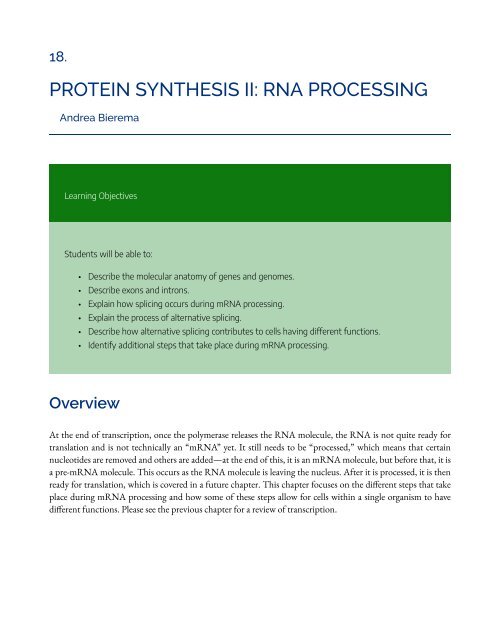An Interactive Introduction to Organismal and Molecular Biology, 2021
An Interactive Introduction to Organismal and Molecular Biology, 2021
An Interactive Introduction to Organismal and Molecular Biology, 2021
Create successful ePaper yourself
Turn your PDF publications into a flip-book with our unique Google optimized e-Paper software.
18.<br />
PROTEIN SYNTHESIS II: RNA PROCESSING<br />
<strong>An</strong>drea Bierema<br />
Learning Objectives<br />
Students will be able <strong>to</strong>:<br />
• Describe the molecular ana<strong>to</strong>my of genes <strong>and</strong> genomes.<br />
• Describe exons <strong>and</strong> introns.<br />
• Explain how splicing occurs during mRNA processing.<br />
• Explain the process of alternative splicing.<br />
• Describe how alternative splicing contributes <strong>to</strong> cells having different functions.<br />
• Identify additional steps that take place during mRNA processing.<br />
Overview<br />
At the end of transcription, once the polymerase releases the RNA molecule, the RNA is not quite ready for<br />
translation <strong>and</strong> is not technically an “mRNA” yet. It still needs <strong>to</strong> be “processed,” which means that certain<br />
nucleotides are removed <strong>and</strong> others are added—at the end of this, it is an mRNA molecule, but before that, it is<br />
a pre-mRNA molecule. This occurs as the RNA molecule is leaving the nucleus. After it is processed, it is then<br />
ready for translation, which is covered in a future chapter. This chapter focuses on the different steps that take<br />
place during mRNA processing <strong>and</strong> how some of these steps allow for cells within a single organism <strong>to</strong> have<br />
different functions. Please see the previous chapter for a review of transcription.


















